The Role of the Photon Counting Loss Effect in Time-Resolved Measurements of Fluorescence Anisotropy
Abstract
1. Introduction
2. Materials and Methods
3. Results and Discussion
3.1. Estimating the Photon Counting Loss Effect in the Detection Set-Up System
3.2. Selection of Optimal Conditions for Detecting Polarized Fluorescence of Phthalocyanines
3.3. Influence of the PCL Effect on the Decay of Pc Fluorescence Anisotropy
3.4. Temperature Dependence of the PCL Effect
3.5. Effect of Fluorophore Photobleaching on the Pc Fluorescence Anisotropy Decay and the PCL Effect
4. Conclusions
Author Contributions
Funding
Institutional Review Board Statement
Informed Consent Statement
Data Availability Statement
Conflicts of Interest
Appendix A

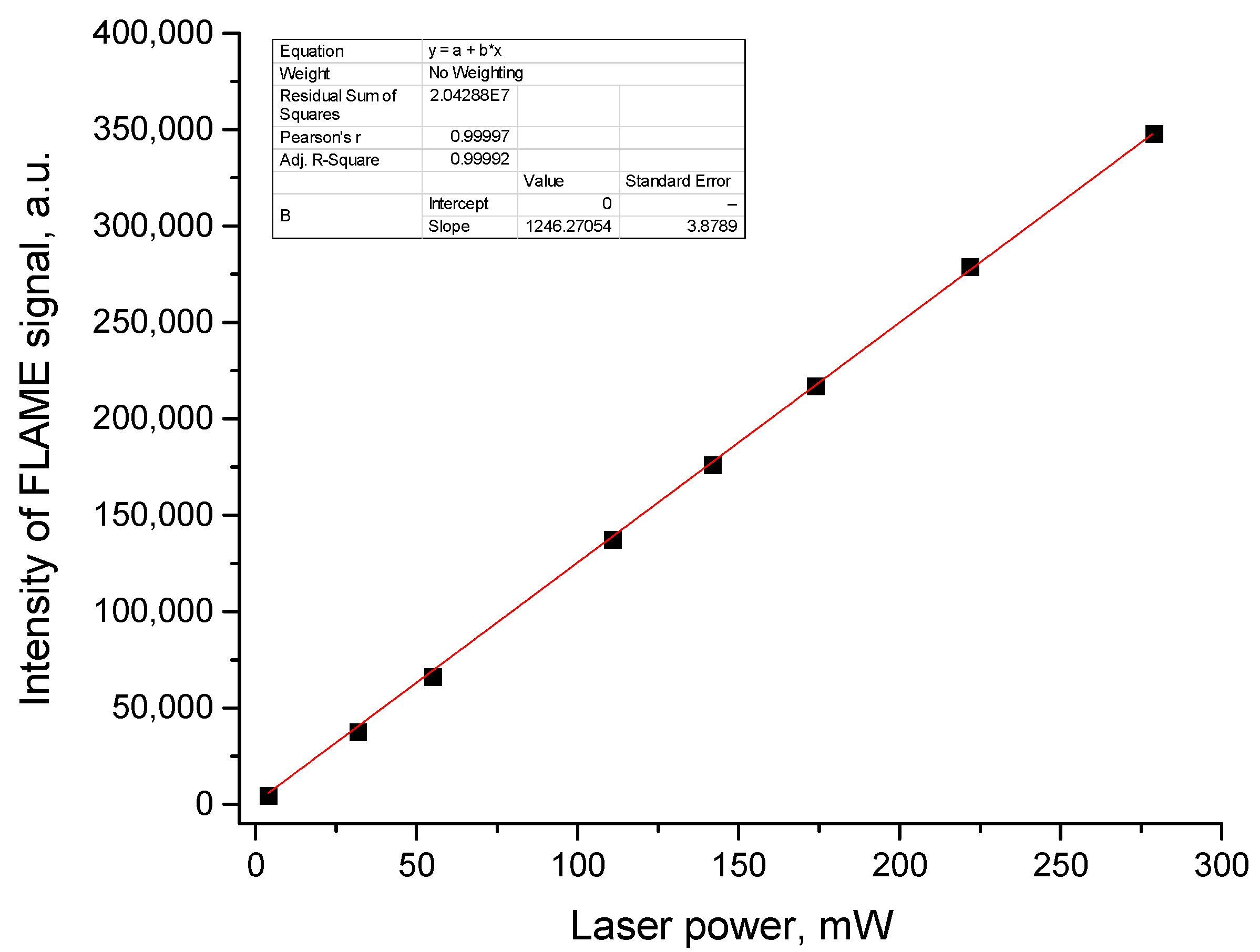
References
- Kawski, A.; Gryczyński, Z. On the Determination of Transition-Moment Directions from Emission Anisotropy Measurements. Z. Naturforsch. A 1986, 41, 1195–1199. [Google Scholar] [CrossRef]
- Albrecht, A.C. Polarizations and assignments of transitions: The method of photoselection. J. Mol. Spectrosc. 1961, 6, 84–108. [Google Scholar] [CrossRef]
- Lakowicz, J.R. Fluorescence Anisotropy. In Principles of Fluorescence Spectroscopy; Springer: Boston, MA, USA, 1999; pp. 291–319. [Google Scholar] [CrossRef]
- Semenov, A.N.; Gvozdev, D.A.; Zlenko, D.V.; Protasova, E.A.; Khashimova, A.R.; Parshina, E.Y.; Baizhumanov, A.A.; Lotosh, N.Y.; Kim, E.E.; Kononevich, Y.N.; et al. Modulation of Membrane Microviscosity by Protein-Mediated Carotenoid Delivery as Revealed by Time-Resolved Fluorescence Anisotropy. Membranes 2022, 12, 905. [Google Scholar] [CrossRef] [PubMed]
- Miao, W.; Yu, C.; Hao, E.; Jiao, L. Functionalized BODIPYs as Fluorescent Molecular Rotors for Viscosity Detection. Front. Chem. 2019, 7, 825. [Google Scholar] [CrossRef] [PubMed]
- Baffou, G.; Kreuzer, M.P.; Kulzer, F.; Quidant, R. Temperature mapping near plasmonic nanostructures using fluorescence polarization anisotropy. Opt. Express 2009, 17, 3291. [Google Scholar] [CrossRef] [PubMed]
- Jain, P.; Aida, T.; Motosuke, M. Fluorescence Anisotropy as a Temperature-Sensing Molecular Probe Using Fluorescein. Micromachines 2021, 12, 1109. [Google Scholar] [CrossRef] [PubMed]
- Wahl, P.; Paoletti, J.; Le Pecq, J.-B. Decay of Fluorescence Emission Anisotropy of the Ethidium Bromide-DNA Complex Evidence for an Internal Motion in DNA. Proc. Natl. Acad. Sci. USA 1970, 65, 417–421. [Google Scholar] [CrossRef] [PubMed]
- Walport, L.J.; Low, J.K.K.; Matthews, J.M.; Mackay, J.P. The characterization of protein interactions—What, how and how much? Chem. Soc. Rev. 2021, 50, 12292–12307. [Google Scholar] [CrossRef] [PubMed]
- Holowka, D.; Wensel, T.; Baird, B. A nanosecond fluorescence depolarization study on the segmental flexibility of receptor-bound immunoglobulin E. Biochemistry 1990, 29, 4607–4612. [Google Scholar] [CrossRef] [PubMed]
- Das, D.; Arora, L.; Mukhopadhyay, S. Short-Range Backbone Dihedral Rotations Modulate Internal Friction in Intrinsically Disordered Proteins. J. Am. Chem. Soc. 2022, 144, 1739–1747. [Google Scholar] [CrossRef] [PubMed]
- Birch, D.J.S.; Imhof, R.E. Time-Domain Fluorescence Spectroscopy Using Time-Correlated Single-Photon Counting. In Topics in Fluorescence Spectroscopy: Techniques; Kluwer Academic Publishers: Boston, MA, USA, 1999; pp. 1–95. [Google Scholar] [CrossRef]
- Becker, W. Advanced Time-Correlated Single Photon Counting Techniques; Springer: Berlin, Germany, 2005. [Google Scholar]
- Becker, W. The bh TCSPC Handbook, 9th ed.; Becker & Hickl GmbH: Berlin, Germany, 2021; pp. 281–284. [Google Scholar]
- Salthammer, T. Numerical simulation of pile-up distorted time-correlated single photon counting (TCSPC) data. J. Fluoresc. 1992, 2, 23–27. [Google Scholar] [CrossRef] [PubMed]
- Isbaner, S.; Karedla, N.; Ruhlandt, D.; Stein, S.C.; Chizhic, A.; Gregor, I.; Enderlein, J. Dead-time correction of fluorescence lifetime measurements and fluorescence lifetime imaging. Opt. Express 2016, 24, 9429. [Google Scholar] [CrossRef] [PubMed]
- Kubista, M.; Aakerman, B.; Albinsson, B. Characterization of the electronic structure of 4′,6-diamidino-2-phenylindole. J. Am. Chem. Soc. 1989, 111, 7031–7035. [Google Scholar] [CrossRef]
- Prazeres, T.J.V.; Fedorov, A.; Barbosa, S.P.; Martinho, J.M.G.; Berberan-Santos, M.N. Accurate Determination of the Limiting Anisotropy of Rhodamine 101. Implications for Its Use as a Fluorescence Polarization Standard. J. Phys. Chem. A 2008, 112, 5034–5039. [Google Scholar] [CrossRef] [PubMed]
- Kim, D.; Osuka, A. Directly Linked Porphyrin Arrays with Tunable Excitonic Interactions. Acc. Chem. Res. 2004, 37, 735–745. [Google Scholar] [CrossRef] [PubMed]
- Maiti, N.C.; Mazumdar, S.; Periasamy, N. Dynamics of Porphyrin Molecules in Micelles. Picosecond Time-Resolved Fluorescence Anisotropy Studies. J. Phys. Chem. 1995, 99, 10708–10715. [Google Scholar] [CrossRef]
- Lakowicz, J.R.; Knutson, J.R. Hindered depolarizing rotations of perylene in lipid bilayers. Detection by lifetime-resolved fluorescence anisotropy measurements. Biochemistry 1980, 19, 905–911. [Google Scholar] [CrossRef] [PubMed]
- Semenov, A.N.; Gvozdev, D.A.; Moysenovich, A.M.; Zlenko, D.V.; Parshina, E.Y.; Baizhumanov, A.A.; Budylin, G.S.; Maksimov, E.G. Probing Red Blood Cell Membrane Microviscosity Using Fluorescence Anisotropy Decay Curves of the Lipophilic Dye PKH26. Int. J. Mol. Sci. 2022, 23, 15767. [Google Scholar] [CrossRef] [PubMed]
- Ha, T.; Glass, J.; Enderle, T.; Chemla, D.S.; Weiss, S. Hindered Rotational Diffusion and Rotational Jumps of Single Molecules. Phys. Rev. Lett. 1998, 80, 2093–2096. [Google Scholar] [CrossRef]
- Gvozdev, D.A.; Ramonova, A.A.; Maksimov, E.G.; Paschenko, V.Z. Specific features of the interaction between chemical traps and phthalocyanine dyes affecting the measurement of the yield of reactive oxygen species. Dye. Pigment. 2020, 181, 108538. [Google Scholar] [CrossRef]
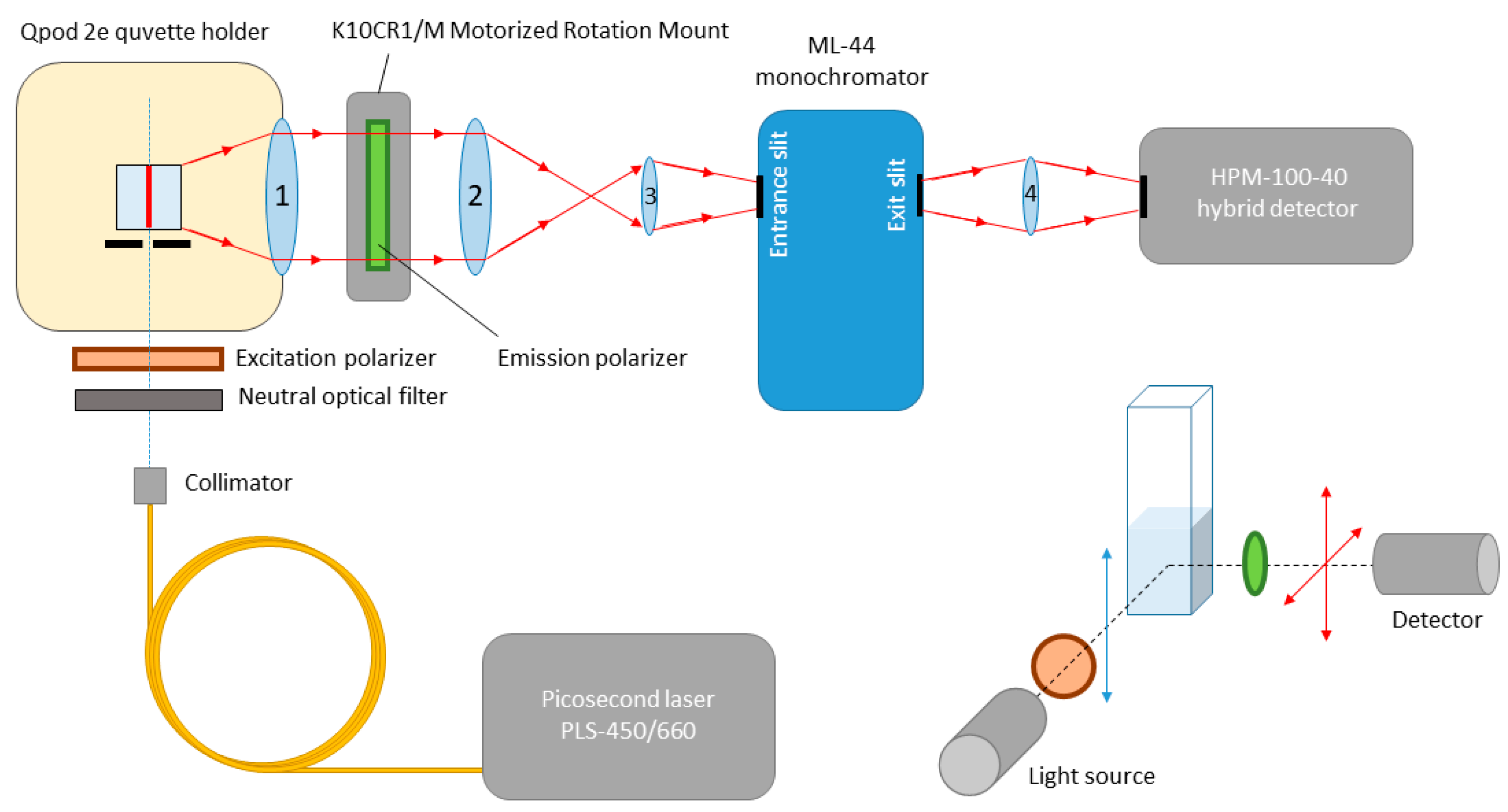
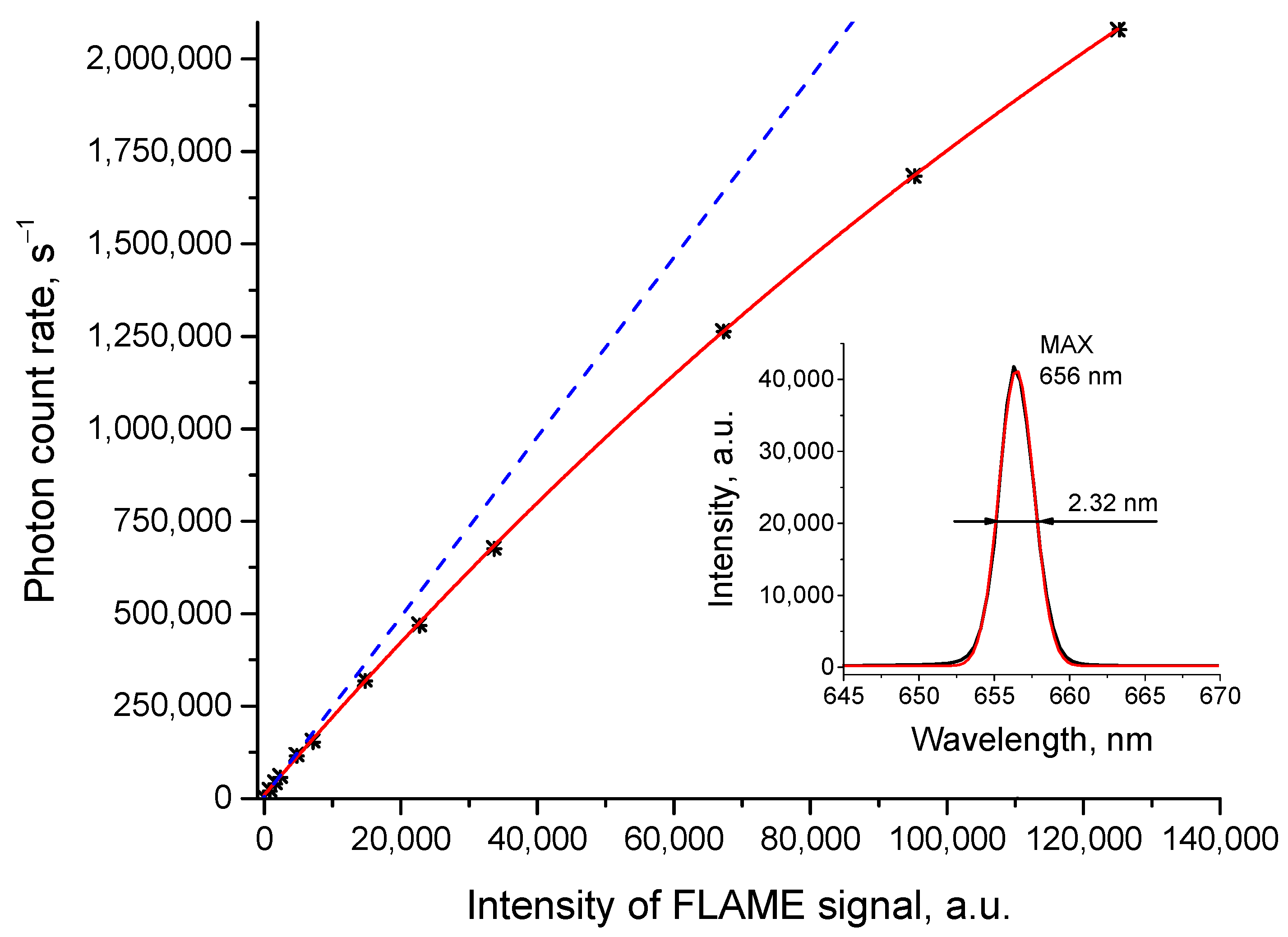
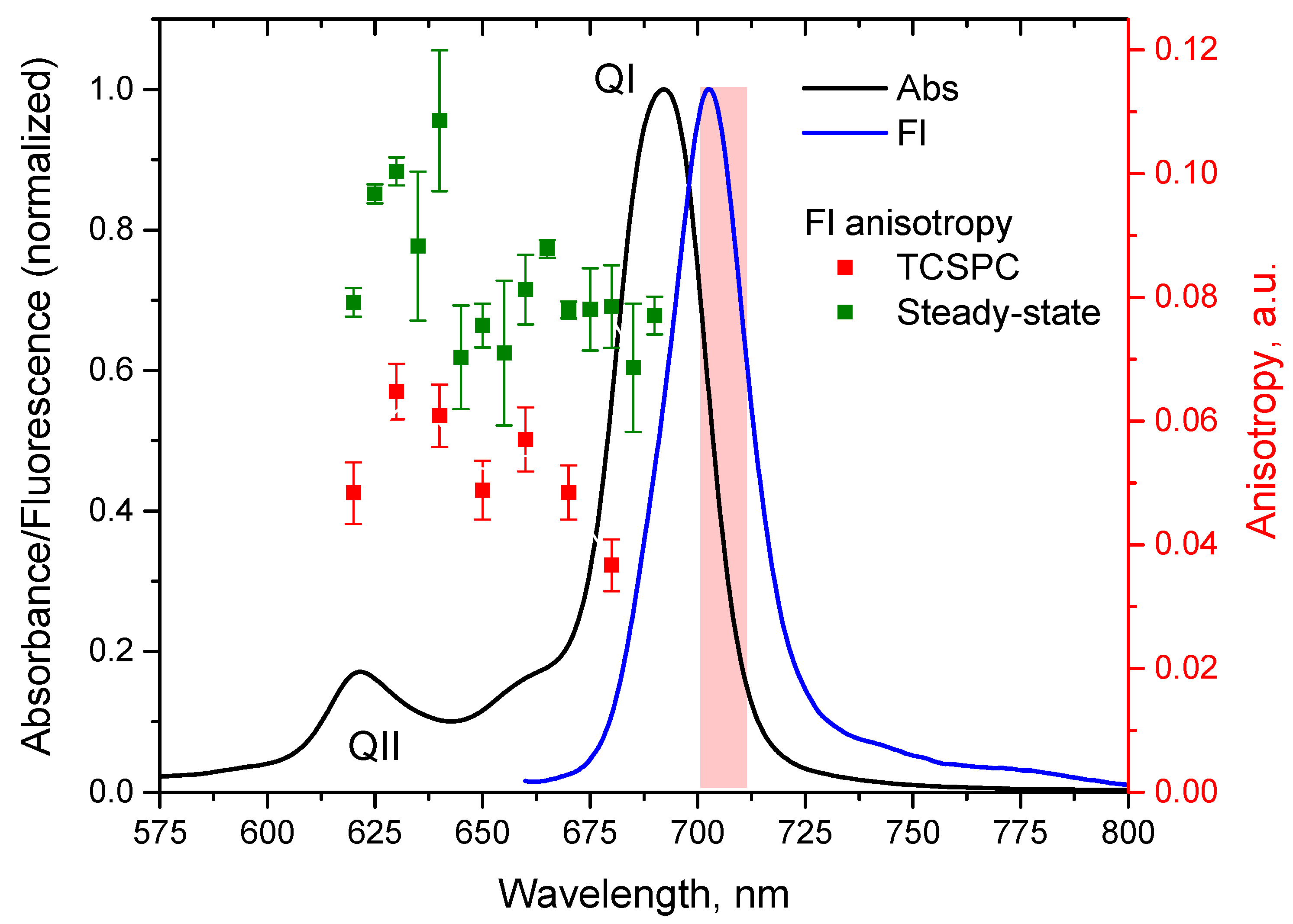
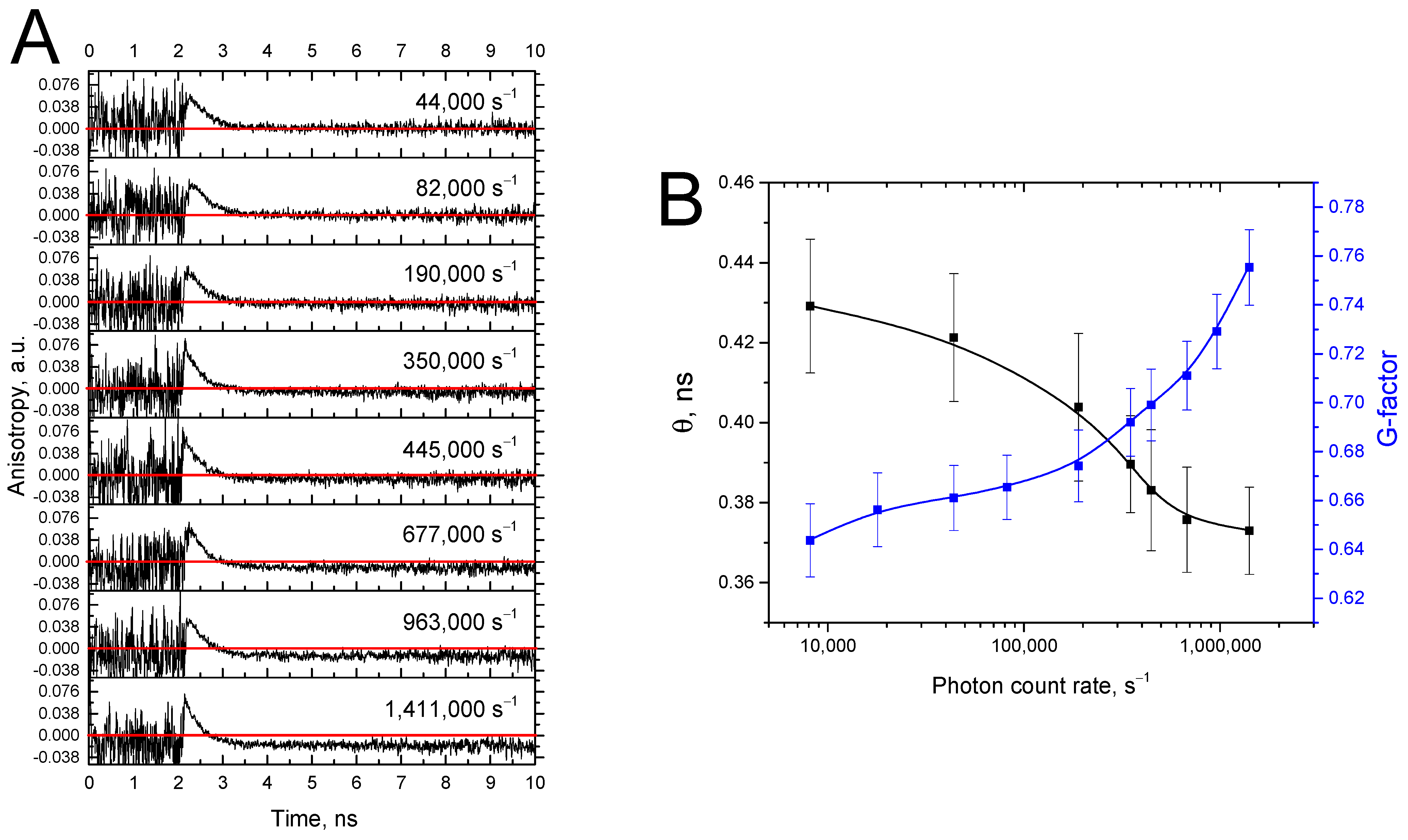
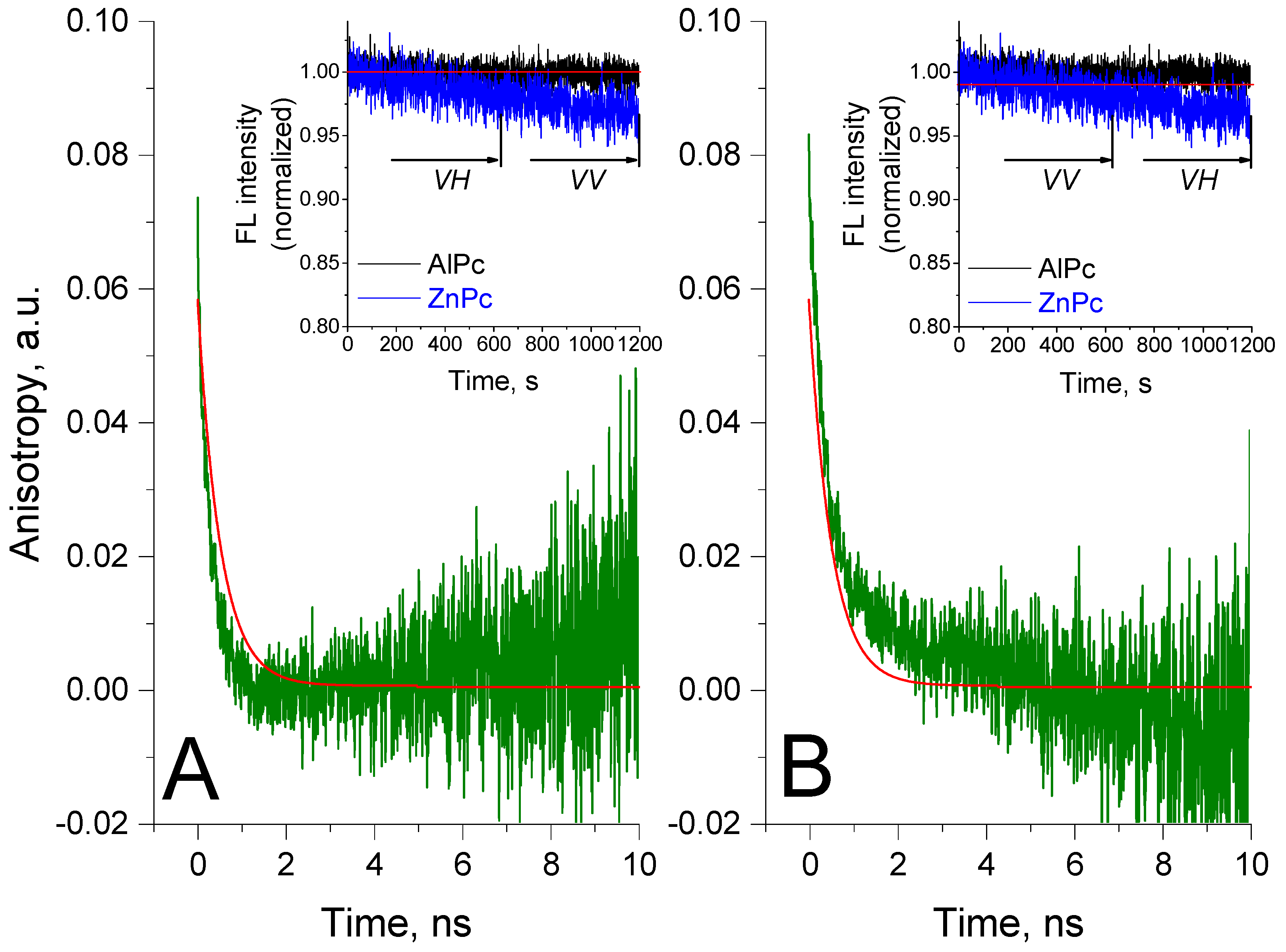
| Fl Intensity, a.u. | ||||
|---|---|---|---|---|
| 15 °C | 216,500 | −0.0039 ± 0.0024 | 0.056 ± 0.001 | 0.54 ± 0.04 |
| 25 °C | 206,350 | −0.0008 ± 0.0022 | 0.057 ± 0.001 | 0.41 ± 0.02 |
| 35 °C | 195,600 | −0.0014 ± 0.0020 | 0.057 ± 0.001 | 0.31 ± 0.02 |
Disclaimer/Publisher’s Note: The statements, opinions and data contained in all publications are solely those of the individual author(s) and contributor(s) and not of MDPI and/or the editor(s). MDPI and/or the editor(s) disclaim responsibility for any injury to people or property resulting from any ideas, methods, instructions or products referred to in the content. |
© 2023 by the authors. Licensee MDPI, Basel, Switzerland. This article is an open access article distributed under the terms and conditions of the Creative Commons Attribution (CC BY) license (https://creativecommons.org/licenses/by/4.0/).
Share and Cite
Gvozdev, D.A.; Semenov, A.N.; Tsoraev, G.V.; Maksimov, E.G. The Role of the Photon Counting Loss Effect in Time-Resolved Measurements of Fluorescence Anisotropy. Photonics 2023, 10, 681. https://doi.org/10.3390/photonics10060681
Gvozdev DA, Semenov AN, Tsoraev GV, Maksimov EG. The Role of the Photon Counting Loss Effect in Time-Resolved Measurements of Fluorescence Anisotropy. Photonics. 2023; 10(6):681. https://doi.org/10.3390/photonics10060681
Chicago/Turabian StyleGvozdev, Daniil A., Alexey N. Semenov, Georgy V. Tsoraev, and Eugene G. Maksimov. 2023. "The Role of the Photon Counting Loss Effect in Time-Resolved Measurements of Fluorescence Anisotropy" Photonics 10, no. 6: 681. https://doi.org/10.3390/photonics10060681
APA StyleGvozdev, D. A., Semenov, A. N., Tsoraev, G. V., & Maksimov, E. G. (2023). The Role of the Photon Counting Loss Effect in Time-Resolved Measurements of Fluorescence Anisotropy. Photonics, 10(6), 681. https://doi.org/10.3390/photonics10060681






